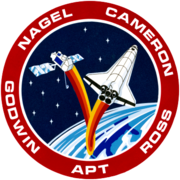STS-37

CGRO is grappled by Atlantis' RMS
|
|
| Mission type | Satellite deployment |
|---|---|
| Operator | NASA |
| COSPAR ID | 1991-027A |
| SATCAT no. | 21224 |
| Mission duration | 5 days, 23 hours, 32 minutes, 44 seconds |
| Distance travelled | 4,002,559 kilometres (2,487,075 mi) |
| Orbits completed | 93 |
| Spacecraft properties | |
| Spacecraft | Space Shuttle Atlantis |
| Landing mass | 86,651 kilograms (191,033 lb) |
| Payload mass | 17,204 kilograms (37,928 lb) |
| Crew | |
| Crew size | 5 |
| Members |
Steven R. Nagel Kenneth D. Cameron Linda M. Godwin Jerry L. Ross Jay Apt |
| Start of mission | |
| Launch date | 5 April 1991, 14:22:45 UTC |
| Launch site | Kennedy LC-39B |
| End of mission | |
| Landing date | 11 April 1991, 13:55:29 UTC |
| Landing site | Edwards Runway 33 |
| Orbital parameters | |
| Reference system | Geocentric |
| Regime | Low Earth |
| Perigee | 450 kilometres (280 mi) |
| Apogee | 462 kilometres (287 mi) |
| Inclination | 28.45 degrees |
| Period | 93.7 minutes |
 Left to right: Cameron, Apt, Nagel, Ross, Godwin |
|
STS-37, the eighth flight of the Space Shuttle Atlantis, was a six-day mission with the primary objective of launching the Compton Gamma Ray Observatory (CGRO), the second of the Great Observatories program which included the visible-spectrum Hubble Space Telescope, the Chandra X-ray Observatory and the infrared Spitzer Space Telescope. The mission also featured two spacewalks, the first since 1985.
The STS-37 mission was successfully launched from launch pad 39B at 9:22:44AM EST on April 5, 1991 from the Kennedy Space Center in Florida. Resumption of the countdown after the T-9 minute hold was delayed about 4 minutes 45 seconds because of two possible weather-condition violations of the launch commit criteria (LCC). The first concerned the cloud ceiling being 500 feet less than the minimum of 8000 feet for a return-to-launch-site (RTLS) abort, and the second concerned the possible weather-condition (wind) effects on blast propagation. Both conditions were found acceptable and the launch countdown proceeded to a satisfactory launch to an inclination of 28.45 degrees. Launch weight: 116,040 kilograms (255,820 lb).
The primary payload, the Gamma Ray Observatory (GRO), was deployed on flight day 3. GRO's high-gain antenna failed to deploy on command; it was finally freed and manually deployed by Ross and Apt during an unscheduled contingency space walk, the first since April 1985. The following day, the two astronauts performed the first scheduled space walk since November 1985 to test means for astronauts to move themselves and equipment about while maintaining the then-planned Space Station Freedom. GRO science instruments were Burst and Transient Source Experiment (BATSE), Imaging Compton Telescope (COMPTEL), Energetic Gamma Ray Experiment Telescope (EGRET) and Oriented Scintillation Spectrometer Experiment (OSSE). GRO was the second of NASA's four Great Observatories. The Hubble Space Telescope, deployed during Mission STS-31 in April 1990, was the first. GRO was launched on a two-year mission to search for the high-energy celestial gamma ray emissions, which cannot penetrate Earth's atmosphere. At about 35,000 pounds, GRO was the heaviest satellite to be deployed into low-Earth orbit from the Shuttle. It was also designed to be the first satellite that could be refueled in orbit by Shuttle crews. Five months after deployment, NASA renamed the satellite the Arthur Holly Compton Gamma Ray Observatory, or Compton Observatory, after the Nobel Prize-winning physicist who did important work in gamma ray astronomy.
...
Wikipedia

